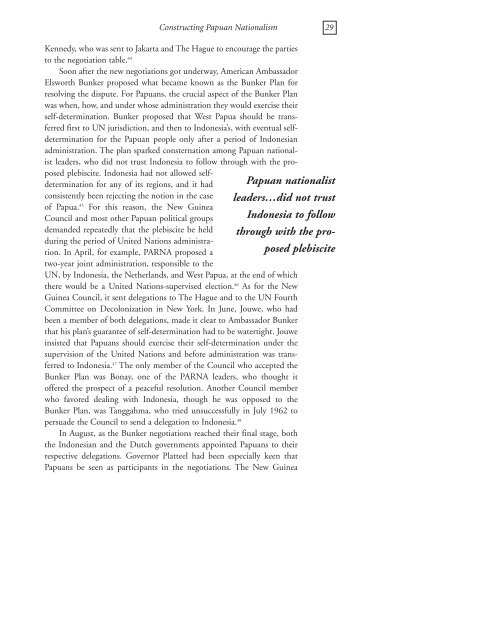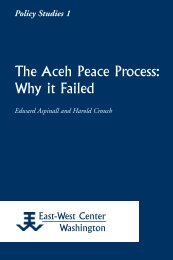Constructing Papuan Nationalism: History, Ethnicity ... - ScholarSpace
Constructing Papuan Nationalism: History, Ethnicity ... - ScholarSpace
Constructing Papuan Nationalism: History, Ethnicity ... - ScholarSpace
- No tags were found...
You also want an ePaper? Increase the reach of your titles
YUMPU automatically turns print PDFs into web optimized ePapers that Google loves.
<strong>Constructing</strong> <strong>Papuan</strong> <strong>Nationalism</strong> 29Kennedy, who was sent to Jakarta and The Hague to encourage the partiesto the negotiation table. 44Soon after the new negotiations got underway, American AmbassadorElsworth Bunker proposed what became known as the Bunker Plan forresolving the dispute. For <strong>Papuan</strong>s, the crucial aspect of the Bunker Planwas when, how, and under whose administration they would exercise theirself-determination. Bunker proposed that West Papua should be transferredfirst to UN jurisdiction, and then to Indonesia’s, with eventual selfdeterminationfor the <strong>Papuan</strong> people only after a period of Indonesianadministration. The plan sparked consternation among <strong>Papuan</strong> nationalistleaders, who did not trust Indonesia to follow through with the proposedplebiscite. Indonesia had not allowed selfdeterminationfor any of its regions, and it hadconsistently been rejecting the notion in the caseof Papua. 45 For this reason, the New GuineaCouncil and most other <strong>Papuan</strong> political groupsdemanded repeatedly that the plebiscite be heldduring the period of United Nations administration.In April, for example, PARNA proposed atwo-year joint administration, responsible to theUN, by Indonesia, the Netherlands, and West Papua, at the end of whichthere would be a United Nations-supervised election. 46 As for the NewGuinea Council, it sent delegations to The Hague and to the UN FourthCommittee on Decolonization in New York. In June, Jouwe, who hadbeen a member of both delegations, made it clear to Ambassador Bunkerthat his plan’s guarantee of self-determination had to be watertight. Jouweinsisted that <strong>Papuan</strong>s should exercise their self-determination under thesupervision of the United Nations and before administration was transferredto Indonesia. 47 The only member of the Council who accepted theBunker Plan was Bonay, one of the PARNA leaders, who thought itoffered the prospect of a peaceful resolution. Another Council memberwho favored dealing with Indonesia, though he was opposed to theBunker Plan, was Tanggahma, who tried unsuccessfully in July 1962 topersuade the Council to send a delegation to Indonesia. 48In August, as the Bunker negotiations reached their final stage, boththe Indonesian and the Dutch governments appointed <strong>Papuan</strong>s to theirrespective delegations. Governor Platteel had been especially keen that<strong>Papuan</strong>s be seen as participants in the negotiations. The New Guinea<strong>Papuan</strong> nationalistleaders…did not trustIndonesia to followthrough with the proposedplebiscite
















